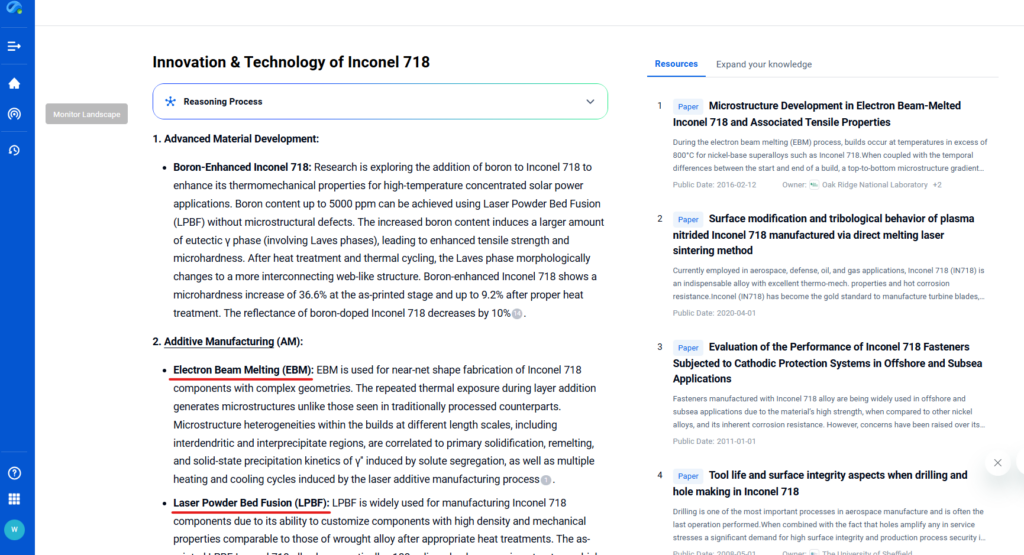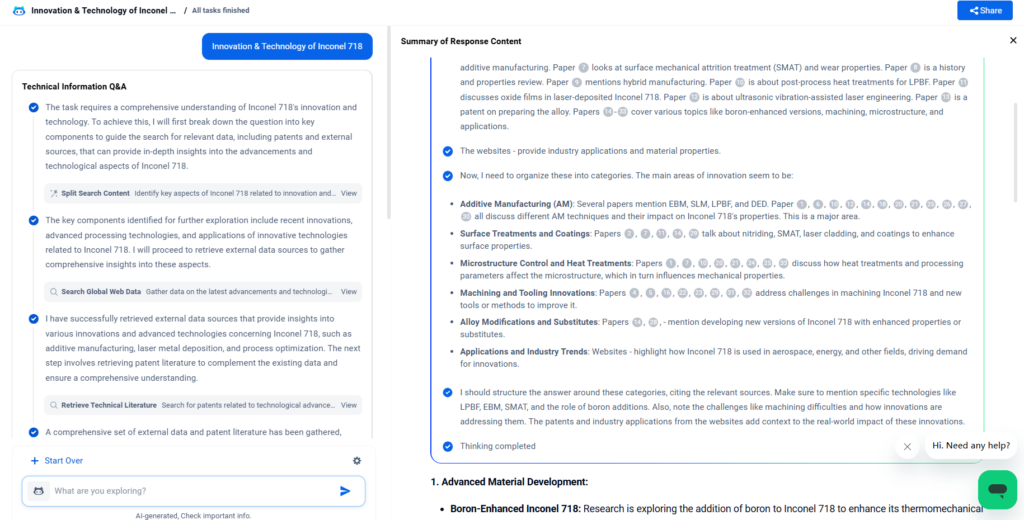
Inconel 718 is a precipitation-hardenable nickel-chromium alloy designed to withstand extreme environments. Its unique ability to maintain mechanical strength, resist oxidation, and perform reliably at high temperatures has made it indispensable in aerospace, energy, and advanced manufacturing. This blog explores the properties, use cases, and future relevance of Inconel 718—one of the most trusted high-performance materials in engineering through PatSnap Eureka AI Agent.
Composition and Key Specifications of Inconel 718
Inconel 718 belongs to the family of nickel-based superalloys. Its distinctive formulation gives it strength, corrosion resistance, and excellent weldability.
| Element | Typical Weight % |
|---|---|
| Nickel (Ni) | 50–55 |
| Chromium (Cr) | 17–21 |
| Iron (Fe) | Balance |
| Niobium (Nb) + Tantalum (Ta) | 4.75–5.5 |
| Molybdenum (Mo) | 2.8–3.3 |
| Titanium (Ti) | 0.65–1.15 |
| Aluminum (Al) | 0.2–0.8 |
Standards and Designations:
- ASTM B637
- UNS N07718
- AMS 5662 / AMS 5663

Mechanical and Thermal Properties of Inconel 718
| Property | Value |
|---|---|
| Yield Strength (0.2% offset) | ~1030 MPa (149 ksi) |
| Tensile Strength | ~1240 MPa (180 ksi) |
| Elongation | ~12% |
| Hardness (Rockwell C) | ~40–45 |
| Operating Temperature Range | -253°C to 704°C (-423°F to 1300°F) |
| Creep Resistance | Excellent up to 650°C |
These characteristics make it an ideal candidate for applications where strength and stability under thermal stress are non-negotiable.
Core Applications Across Industries of Inconel 718
Aerospace and Jet Engines
It plays a crucial role in the aerospace sector, especially in jet engine and airframe components that demand extreme strength under high temperatures. The alloy is commonly used in turbine disks, compressor blades, and high-strength fasteners, where its exceptional fatigue resistance and creep rupture strength are indispensable. Thanks to its ability to maintain mechanical integrity at elevated temperatures, Inconel 718’s aerospace applications continue to expand into next-generation propulsion systems and supersonic flight designs. It remains a preferred choice for jet engine parts operating under prolonged thermal and mechanical stress.
Gas Turbines and Power Generation
In high-efficiency power systems, It offers a combination of oxidation resistance, creep strength, and thermal stability—qualities that make it essential for superalloy turbine blades, transition ducts, and combustion liners. Its proven performance in gas turbine hot-section components under cyclic loading extends the operational life of critical parts and supports aggressive thermal cycling strategies. As a result, Inconel 718 in gas turbines is regarded as a foundational material, helping power plants improve both uptime and output.
Additive Manufacturing (3D Printing)
Inconel 718’s compatibility with additive manufacturing technologies has opened new doors for customized, high-performance components in aerospace, energy, and biomedical applications. In laser powder bed fusion (LPBF) and direct energy deposition (DED), the alloy’s stable microstructure and low susceptibility to cracking during rapid solidification offer significant design freedom. Engineered Inconel 718 3D printing powders support the fabrication of intricate parts with high dimensional accuracy, while nickel alloy additive manufacturing methods allow for topology-optimized geometries with minimal post-processing requirements.
Oil & Gas and Marine Engineering
From subsea drilling tools to high-pressure pump housings, Inconel 718’s corrosion resistance in aggressive environments like chlorides and hydrogen sulfide is critical. Its ability to withstand pitting, crevice corrosion, and sulfide stress cracking makes it ideal for nickel alloy downhole tools, risers, and subsea wellhead components. Inconel 718’s mechanical stability under high pressure and temperature conditions ensures long-term reliability in oil exploration and offshore production platforms, especially in deepwater and high-pressure/high-temperature (HPHT) wells.
Why Choose Inconel 718 Over Other Superalloys?
| Parameter | Inconel 718 | Inconel 625 | Titanium Alloys |
|---|---|---|---|
| Cost | Moderate | High | Moderate |
| Strength @ High Temp | Excellent | Moderate | Moderate |
| Weldability | Excellent | Moderate | Poor |
| Fatigue Resistance | Superior | Good | Fair |
| Availability | Widely available | Moderate | High |
It strikes a compelling balance between cost, strength, weldability, and fatigue resistance, making it a “go-to” alloy in many mission-critical sectors.
Innovation & Technology of Inconel 718
Advanced Processing Techniques
Modern production of Inconel 718 incorporates vacuum induction melting (VIM) and vacuum arc remelting (VAR), which reduce impurities and optimize microstructure. These methods improve mechanical consistency, grain refinement, and fatigue life in critical components.
Heat Treatment Advancements
Innovations in precipitation hardening heat treatment have led to more stable gamma prime (γ′) and gamma double prime (γ″) phases—key to Inconel 718’s strength. Modified aging processes enable tailoring of hardness for application-specific needs, such as aerospace vs. oilfield equipment.
Additive Manufacturing Integration
The integration of real-time process monitoring and AI-based thermal modeling in Inconel 718’s additive manufacturing enhances build consistency and reduces post-processing requirements. These innovations improve reliability for mission-critical parts like turbine blades and medical implants.
Insights from PatSnap Eureka AI Agent
According to Eureka’s patent analytics, leading innovation clusters in Inconel 718 include:

These insights help engineers pinpoint R&D opportunities and reduce time-to-market in high-performance sectors.
Challenges and Limitations of Inconel 718
While highly capable, It has its limitations:
- Machinability: Requires advanced tooling and cooling techniques due to its work-hardening behavior.
- Thermal Conductivity: Lower than many conventional metals, which can limit heat dissipation.
- Cost: More expensive than stainless steel or aluminum alloys, though cheaper than Inconel 625 or Hastelloy X.
Future Outlook: Sustainable Alloys and Design Freedom
The future of Inconel 718 lies in hybrid manufacturing, functionally graded materials, and environmentally optimized supply chains. Innovations in powder metallurgy and recycling of nickel superalloys are helping reduce the carbon footprint of high-temperature alloys.
As industries demand both performance and sustainability, Inconel 718 continues to evolve—from conventionally forged components to topology-optimized, 3D-printed aerospace parts.
Conclusion
From turbine blades to 3D-printed prototypes, Inconel 718 remains one of the most versatile and dependable superalloys on the market. Its combination of strength, corrosion resistance, and weldability has earned it a reputation as the material of choice for extreme conditions.
Whether you’re in aerospace design, energy systems, or additive manufacturing, understanding Inconel 718 is critical for making resilient, high-performance products.
FAQ
A1: While both are high-strength superalloys, Inconel 718 has superior creep resistance and fatigue strength, making it more suitable for cyclic high-stress conditions like jet engine parts.
A2: Yes, it retains ductility and impact strength even at extremely low temperatures, making it useful in cryogenic storage systems and space applications.
A3: Its relatively high residual stress accumulation during rapid solidification may require stress-relief heat treatment. Also, maintaining consistent powder flowability is crucial in powder-based processes.
A4: It offers better oxidation resistance and thermal fatigue performance, while titanium alloys are generally lighter and used where weight savings are critical.
A5: Yes, It can be recycled through vacuum re-melting processes, though the cost is high. Recycling maintains its mechanical properties, supporting sustainability in aerospace and energy sectors.
Ready to explore how Inconel 718 can improve your next engineering challenge? Let PatSnap Eureka AI Agent help you stay ahead of material innovation and application trends.




